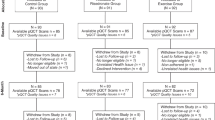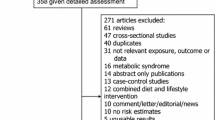Abstract.
Lifetime occupational and leisure time activities were assessed by a questionnaire in order to evaluate their relationship to bone mass measurements and biochemical markers of bone metabolism in a population of 61 women and 61 men, randomly selected from a Swedish population register, to represent ages between 22 and 85 years. We also considered possible confounders by using questions about smoking habits, milk consumption, hormone replacement therapy (HRT), and menopausal age. Bone mineral density (BMD) and bone mineral content (bone mass, BMC) of the total body, lumbar spine, and proximal femur (neck, trochanter, Ward's triangle) were measured by dual energy X-ray absorptiometry (DXA), and BMD of the forearm with single energy X-ray absorptiometry (SXA). In addition, both DXA and SXA provided information on bone area. Quantitative ultrasound measurements (QUS) at the heel were performed to assess the speed of sound (SOS) and broadband ultrasound attenuation (BUA). Fasting blood samples were analyzed for biochemical markers of bone metabolism as well as parathyroid hormone (PTH) and total serum calcium. After adjustment for confounding factors, neither BMD nor QUS measurements were consistently related to lifetime leisure time or occupational activities; nor were there any consistent patterns relating biochemical markers of bone metabolism to bone mass measurements. However, physical activity seemed to influence bone mass, area, and width more than density. In men, high levels of leisure time activity were associated with raised values for lumbar spine area (6.2%) and width (3.3%) as well as for femoral neck area (5.5%) compared with their low activity counterpart. Men exposed to high levels of occupational activity demonstrated lower lumbar spine BMD (10.9%) and area (5.3%) than men with low activity levels. Within an unselected Swedish population, estimation of lifetime occupational and sport activities as well as bedrest, using a questionnaire, demonstrated no major effects on bone density. However, the association between high levels of lifetime activity and raised values for bone mass, area, and width indicate that geometrical changes in bone may provide better estimations of mechanically induced bone strength than bone density, at least in men.
Similar content being viewed by others
Author information
Authors and Affiliations
Additional information
Received: 20 May 1997 / Accepted: 15 October 1997
Rights and permissions
About this article
Cite this article
Brahm, H., Mallmin, H., Michaëlsson, K. et al. Relationships Between Bone Mass Measurements and Lifetime Physical Activity in a Swedish Population. Calcif Tissue Int 62, 400–412 (1998). https://doi.org/10.1007/s002239900452
Issue Date:
DOI: https://doi.org/10.1007/s002239900452




